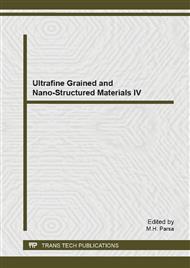[1]
T. Sourmail, Near equiatomic FeCo alloys: constitution, mechanical and magnetic properties, Prog. Mater. Sci. 50 (2005) 816-880.
DOI: 10.1016/j.pmatsci.2005.04.001
Google Scholar
[2]
M. Delshad Chermahini and H. Shokrollahi, Milling and subsequent thermal annealing effects on the microstructural and magnetic properties of nanostructured Fe90Co10 and Fe65Co35 powders, J. Alloy. Compd. 480 (2009) 161–166.
DOI: 10.1016/j.jallcom.2009.01.088
Google Scholar
[3]
Y. Liu, J. Zhang, L. Yu, G. Jia, C. Jing and S. Cao, Magnetic properties of nanocrystalline Fe–Co alloys by high-energy milling, J. Alloy. Compd. 377 (2004) 202-206.
DOI: 10.1016/j.jallcom.2003.12.037
Google Scholar
[4]
H. Moumeni, S. Alleg and J.M. Greneche, Structural properties of Fe50Co50 nanostructured powder prepared by mechanical alloying, J. Alloy. Compd. 386 (2005) 12-19.
DOI: 10.1016/j.jallcom.2004.05.017
Google Scholar
[5]
Q. Zeng, I. Baker, V. McCreary and Zh. Yan, Soft ferromagnetism in nanostructured mechanical alloying FeCo-based powders, J. Magn. Magn. Mater. 318 (2007) 28–38.
DOI: 10.1016/j.jmmm.2007.04.037
Google Scholar
[6]
S.P. Gubin, Magnetic Nanoparticles, WILEY-VCH, Weinheim, (2009).
Google Scholar
[7]
M. Delshad Chermahini, S. Sharafi, H. Shokrollahi, M. Zandrahimi and A. Shafyei, The evolution of heating rate on the microstructural and magnetic properties of milled nanostructured Fe1-xCox (x = 0. 2, 0. 3, 0. 4, 0. 5 and 0. 7) powders, J. Alloy. Compd. 484 (2009).
DOI: 10.1016/j.jallcom.2009.05.055
Google Scholar
[8]
H.F. Li and R.V. Ramanujan, Synthesis of Fe-Co Based Nanomagnetic Materials, Trans. India. Inst. Met. 58 (2005) 965-970.
Google Scholar
[9]
C. Suryanarayana, Mechanical alloying and milling, Prog. Mater. Sci. 46 (2001) 1-31.
Google Scholar
[10]
B. Zuo and T. Sritharan, Ordering and grain growth in nanocrystalline Fe75Si25 alloy, Acta. Mater. 53 (2005) 1233-1239.
DOI: 10.1016/j.actamat.2004.11.017
Google Scholar
[11]
H. Shokrollahi, K. Janghorban, R. Koohkan and Sh. Sharafi, Preparation of nanocrystalline Fe–Ni powders by mechanical alloying used in soft magnetic composites, J. Magn. Magn. Mater. 320 (2008) 1089-1092.
DOI: 10.1016/j.jmmm.2007.10.033
Google Scholar
[12]
H. Shokrollahi and K. Janghorban, Different annealing treatments for improvement of magnetic and electrical properties of soft magnetic composites, J. Magn. Magn. Mater. 317 (2007) 61-67.
DOI: 10.1016/j.jmmm.2007.04.011
Google Scholar
[13]
N. Poudyal, Ch. Rong, Y. Zhang, D. Wanga, M.J. Kramer, R.J. Hebertc and J. Ping Liu, Self-nanoscaling in FeCo alloys prepared via severe plastic deformation, J. Alloy. Compd. 521 (2012) 55-59.
DOI: 10.1016/j.jallcom.2012.01.026
Google Scholar
[14]
M. Tavakoli, H. Shokrollahi, L. Karimi and K. Janghorban, Investigation of structural, microstructural and magnetic properties of mechanically alloyed nanostructured (Fe50Co50)100−xMox(x =25, 35) powders, Powder. Technol. 234 (2013) 13–18.
DOI: 10.1016/j.powtec.2012.09.013
Google Scholar
[15]
E. Lifshin, X-ray Characterization of Materials, WILEY-VCH Verlag GmbH, (1999).
Google Scholar
[16]
B.D. Cullity, Elements of X-ray Diffraction, third edition, Addison-Wesley, (2001).
Google Scholar
[17]
C. Suryanarayana, M. Grant Norton, X- Ray Diffraction a Practical approach, Plenum press, New York and London, (1998).
Google Scholar
[18]
Y. D Kim, J. Y Chung, J. Kim and H. Jeon, Formation of nanocrystalline Fe–Co powders produced by mechanical alloying, Mat. Sci. Eng. A-Struct. 291 (2000) 17-21.
DOI: 10.1016/s0921-5093(00)00982-5
Google Scholar
[19]
H. Moumeni, S. Alleg, C. Djebbari, F. Z. Bentayeb and J. M. Grenèche, Synthesis and characterisation of nanostructured FeCo alloys, J. Mater. Sci. 39 (2004) 5441-5443.
DOI: 10.1023/b:jmsc.0000039262.37788.b7
Google Scholar
[20]
G. González, D. Oleszak, A. Sagarzazu, R. Villalba and L. D'Onofrio, Mechanical Alloying of FeCoCr, Rev. Lat. Am. Metal. Mat. 31 (2011) 64-70.
Google Scholar
[21]
H. A. Baghbaderani, S. Sharafi and M. D. Chermahini, Investigation of nanostructure formation mechanism and magnetic properties in Fe45Co45Ni10 system synthesized by mechanical alloying, Powder. Technol. 230 (2012) 241–246.
DOI: 10.1016/j.powtec.2012.07.039
Google Scholar
[22]
M. McHenry, M. Willard and D. Laughlin, Amorphous and nanocrystalline materials for applications as soft magnets, Prog. Mater. Sci. 44 (1999) 291-433.
DOI: 10.1016/s0079-6425(99)00002-x
Google Scholar


